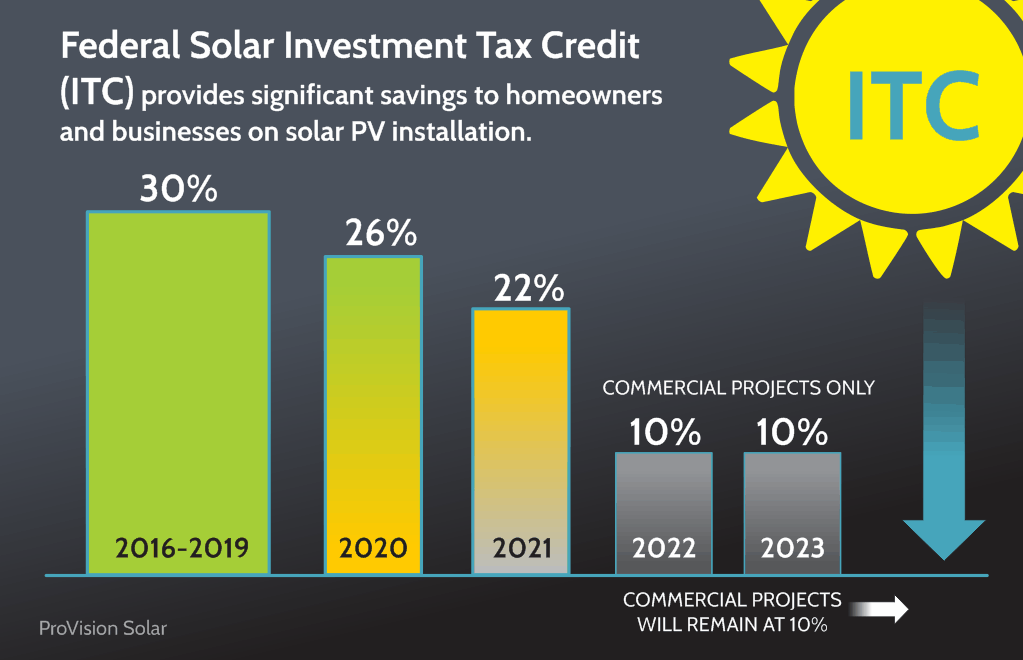Solar Tax Credit Safe Harbor Program
 Since 2006, the Federal Solar Investment Tax Credit (ITC) has provided huge savings on solar installation for businesses. The ITC allows you to recoup 26% of your project cost from your federal taxes, with no cap. On January 1st, 2021 the ITC is dropping to 22%.
Since 2006, the Federal Solar Investment Tax Credit (ITC) has provided huge savings on solar installation for businesses. The ITC allows you to recoup 26% of your project cost from your federal taxes, with no cap. On January 1st, 2021 the ITC is dropping to 22%.
Installing a grid-tied solar PV system is a lengthy process of engineering, permitting and inspections and the ITC requires that the solar PV system be completed in order for it to be claimed in that year's taxes.
Thanks to the Safe Harbor provision, businesses can still get 26% tax credit if they invest at least 5% of the total system cost prior to the end of 2020. By investing 5% up-front, Safe Harbor allows commercial solar projects to receive the 2020 full 26% tax credit, even if your system is not completed until the following year.
Attention Business & Farm Owners!
There's still time to qualify for 26% ITC tax credit for new solar projects completed after 2020. Ask us about Safe Harbor today! Time is limited.
Don't wait until the last minute to get your project underway!
In order to ensure your business' solar project will comply with Safe Harbor requirements we have set the deadline of September 30th to accept new Safe Harbor commercial projects.
How Do I Qualify for the Safe Harbor Provision for Solar?
If you're a business or farm looking to install a solar PV system, you can take advantage of the full 30% tax credit in 2019 if your solar system is completed by 2023.
Here are a few steps you need to follow in order to qualify for the ITC Safe Harbor provision.
- Get a bid from a contractor of your choice.
- Begin the design and permitting process
- Incur 5% or more of the total installation cost in the year construction begins; or start physical work of a significant nature.
Option 1:
The 5% Investment
How It Works
For this option, you must pay at least 5% of the project's total cost in 2019. The solar installer must use that 5% deposit for legitimate project costs before midnight on January 1, 2020. That payment is nonrefundable, even if you later decide to cancel the project.
Your 5% investment covers costs such as: engineering; permitting; interconnection fees and applications; utility upgrades or new services; or materials for your system. Your solar consultant will advise you on the best course of action depending on the timing, your system, and your situation.
The Risks
In order to satisfy the safe harbor requirements, at least 5% of the system's cost must be invested in the system in 2019. If your project increases in price for any reason, making the money you invested less than 5%, you'll no longer be eligible for the 30% tax credit. Cost increases can be due to factors outside of your control, like tariffs or code changes, or if you'd like to redesign your system. Regardless of unforeseen cost increases, the investment made in 2019 must be at least 5% of the final cost of the project. A wise course of action is to invest 6-7% in order to future-proof your investment to allow for unexpected cost increases.
Regardless of the amount, the payment is not refundable. If you decide to not install your project for any reason, you will lose the investment.
Option 2:
Beginning of Construction with Continuous Work
How It Works
This option is most often going to apply to very large projects. It requires two conditions to be met:
- Work on the project has to be started in 2019, and
- Work must progress in a continuous nature.
To satisfy this option for the safe harbor, there has to be evidence that some portion of the project has started, whether that's on-site or off-site work, and that it has continued after 2019. The work must be considered "significant in nature" in order to comply with Safe Harbor. There is no specific amount of work or monetary investment needed to qualify for the Safe Harbor in this option, though the IRS indicated the taxpayer must make "continuous effort to advance towards completion of the energy property."
The Risks
This option is the trickier of the two options because of its ambiguity. You should be prepared to defend the continuity of the project's work to the IRS, you should also be able to back your claims up with documentation.
Slipping up on this could cost you. If a mistake is made, you may not only lose the 4% difference in the ITC, but you could also lose out on the ITC all together and incur expensive professional costs as you work with the IRS.
Using Safe Harbor requires careful attention to timelines and paper work. Your ProVision Solar consultant manages this process for you to ensure you experience a smooth process from start to finish.
The Safe Harbor ITC provision is a safe and effective way to ensure you'll be getting the most out of your solar investment. Consult your tax professional to ensure all your bases are covered before proceeding with the Safe Harbor.
![ProVisionSolar_White-Green[2] ProVisionSolar_White-Green[2]](https://www.provisionsolar.com/wp-content/uploads/2018/06/ProVisionSolar_White-Green2.png)